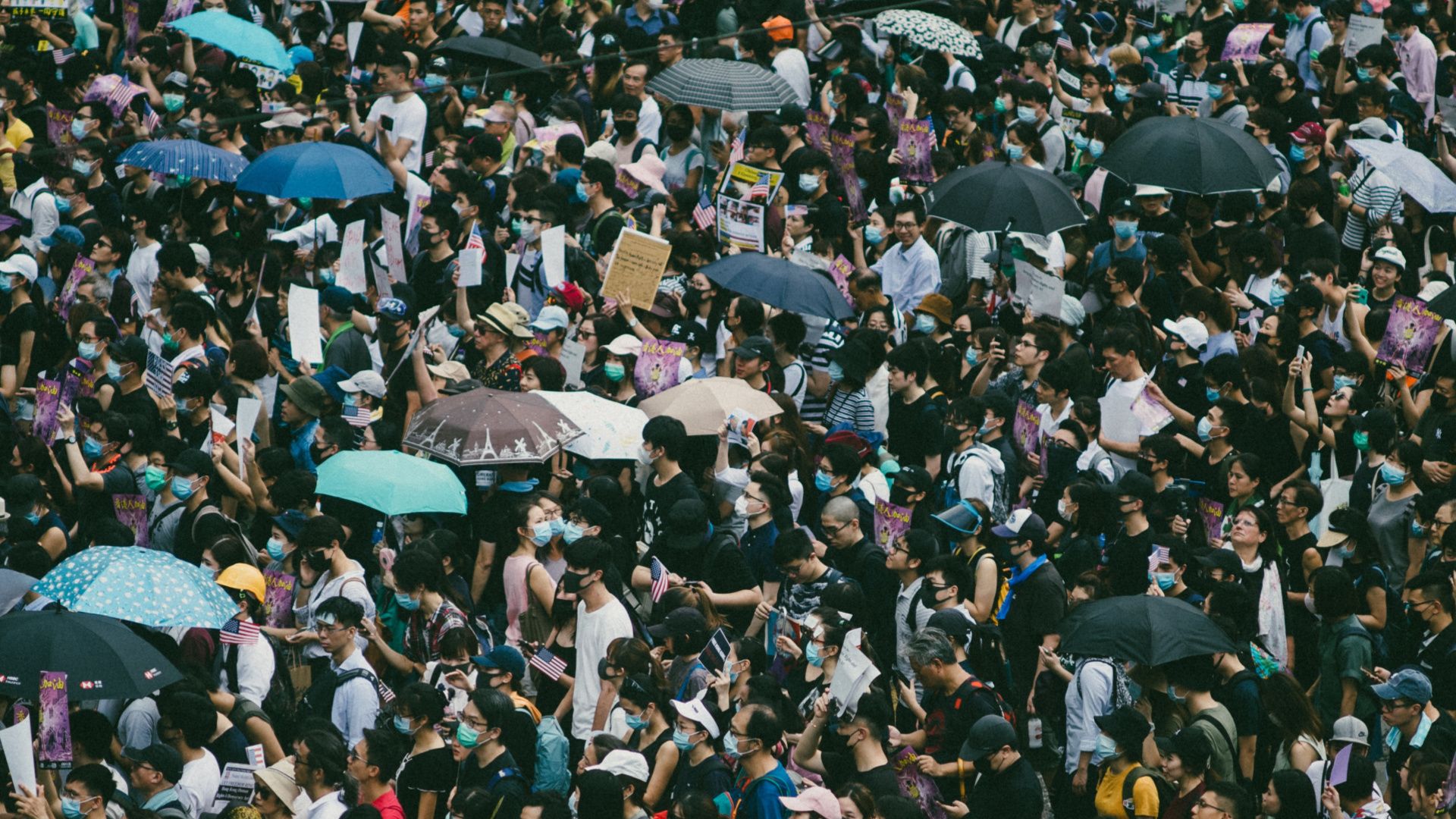In March, the Reuters news agency published a review of more than 2,000 Russian court cases showing security-camera footage and facial-recognition technology having been used in the arrests of hundreds of people. Initially, authorities were using the technology to identify and detain people who’d joined various anti-government demonstrations, but after the invasion of Ukraine last year, they started using it to intercept protesters and prevent them from demonstrating at all. Now they’re using it to spot and whisk away opponents of the Kremlin whenever they want. It’s a remarkable story—and just one in a developing pattern of autocratic regimes using technologies powered by artificial intelligence to clamp down on their populations. What’s the extent of all this?
Steven Feldstein is a senior fellow at the Carnegie Endowment for International Peace and the author of The Rise of Digital Repression: How Technology Is Reshaping Politics, Power, and Resistance. As Feldstein explains, repression-enabling AI applications have become key elements of the authoritarian repertoire globally. Autocrats have invested heavily in them because, although they’ve insulated their power and rolled back democratic movements in recent years, they still understand that the biggest enduring threat to that power in the contemporary world is their own people, either rising up in revolutions or voting them out in elections. And the biggest emerging opportunity to control people is by connecting the digital environments they increasingly live in to state surveillance systems powered by AI.
This article is part of a series in partnership with the Human Rights Foundation. Feldstein will be a speaker at the Oslo Freedom Forum in June.
J.J. Gould: How have autocratic authorities been using artificial intelligence?
Steven Feldstein: There was a moment in the early 2010s when new digital-information and -communication platforms—social-media applications especially—had started to play this remarkable role in helping civilians around the world mobilize and challenge the autocracies they were living under. We saw this in the color revolutions in post-Soviet Eurasia through the Arab Spring. And it led to a lot of optimism that these liberation technologies—as they were called—would help propel a new wave of democratic revolutions globally.
What’s actually happened, alas, is that autocratic governments have figured out how to use new digital technologies—AI applications especially—to repress their citizens more effectively, undercut emerging liberation movements, and reinforce autocratic political power. We’ve seen this above all in China—but also in Russia, the Gulf states, and other authoritarian and illiberal regimes. The range of applications has been expanding, but a few use cases stand out.
One is tracking popular discontent and, when it comes to it, controlling mass protest. That can work in a number of different ways. It can work on a mass scale through automated social-media monitoring, interpreting what people are thinking from what they’re saying online. It can work through public-surveillance cameras and other ways of seeing when and where people are gathering—and then preempting political demonstrations or arresting people who participate in them. We’ve seen this increasingly in Russia, for example, in these techniques Moscow uses to pick up and neutralize anti-war protesters. Denley
Denley
 Denley
DenleyA second use case is maintaining control in an area of a country where the state is experiencing unrest. China’s Xinjiang province, where there’s ongoing dissatisfaction and pushback against Beijing among the region’s Uyghur population, is a prominent example. Here, Chinese authorities continue to use traditional autocratic repression tactics, including brutal reeducation camps. But they’re also supplementing these traditional tactics with advanced machine-learning technologies—facial-recognition platforms, biometric scanning, genomic surveillance, and so on—which the regime can integrate with an information-management system that enables predictive policing carried out by tens of thousands of security officers.
A third use case is super-enhancing propaganda and disinformation. Where an autocratic regime has a constitutional obligation to hold formal elections, for instance, and where it might have conventionally used methods of rigging those elections like ballot-stuffing or voter suppression, it’s now more and more likely to augment those methods with AI technology. It can now collaborate with bot and troll armies to spread approved messaging. It can identify and engage key social-media influencers. It can leverage social-media platforms to push out automatic, hyper-personalized disinformation campaigns. And it can use deep-fake technology to generate ever-more realistic audio and video forgeries to discredit challengers.
Autocratic governments have figured out how to use new digital technologies to repress their citizens more effectively, undercut emerging liberation movements, and reinforce autocratic political power.
Gould: Why the demand for repression-enabling AI technology? Haven’t traditional autocratic means of repression worked just fine in preventing a new wave of democracy globally?
Feldstein: From the end of World War II through the late 1980s, the most common way for an autocrat to lose power was a coup—which is to say, by being forced out by elite competitors internal to the regime. After the Cold War, the threat started to shift toward popular challengers external to the regime—namely, toward mass revolts or electoral defeats. The implication for autocrats has been a need to focus on controlling those challengers—by repressing popular civic movements and manipulating elections.
There’s a very direct logic aligning this perceived need with AI technologies. The application of these technologies for political repression can be expensive to develop—but in the end, not as expensive, in terms of either resource costs or political risks, as relying wholly on the manual work, as it were, of old-fashioned security forces. So in the context of the shifting threat to autocrats, AI technologies have improved both the effectiveness and efficiency of political repression. Advertisement
Advertisement
 Advertisement
AdvertisementGould: What about the supply side of this technology’s proliferation? To what extent is it being driven by Chinese innovation—and maybe an incentive to market it to autocrats globally, enhancing China’s influence and power?
Feldstein: When we look at the incentives driving the export of these technologies, there are push and pull dynamics. On the one hand, Beijing has readily made these tools available to other autocratic rulers, both by demonstrating what’s possible to acquire and by subsidizing its acquisition. And China has seen benefits from that—directly in economic influence and indirectly in political influence.
On the other hand, these other autocratic rulers already want these tools and are eager to come to those who sell them, whether they’re Chinese companies or not. U.S., European, and Israeli companies also manufacture and sell surveillance equipment, spyware, and other tools for controlling populations.
China has been an innovator in repression-enabling technology, but I wouldn’t say it’s been the innovator. It’s certainly been effective at pushing this technology forward with autocrats globally, but companies from the U.S., Europe, and elsewhere have been in the game to different degrees, as well, all along the way. And as societies all over the world become more digital, as people spend more time online and on digital devices, as all of this becomes more and more central to how human beings live their lives, it becomes a new vector for potential control. It becomes a critical arena for governments to monitor and manage citizens.
Since the Cold War, the threat to autocrats has come from mass revolts and electoral defeats. The implication for autocrats has been a need to focus on repressing popular civic movements and manipulating elections.
So now you have governments all over the world wanting to buy the technologies that enable this monitoring and management, and you have companies all over the world manufacturing and selling them. Autocrats from the Gulf, like Qatar, or from the Middle East, like Egypt, or from South Asia, like Pakistan, are all to some extent importing Chinese technologies. But they’re also importing technologies from companies in other countries, many of which are democratic. The world has become a lot more complicated in that way.
Gould: How do you see the dangers of repression-enabling AI technologies in democratic countries?
Feldstein: A lot of it still remains prospective, but we’ve certainly already seen these tools being used in conjunction with social-media platforms by autocratic states to disrupt elections and undermine social trust among democratic rival states. We’ve also seen them being used by illiberal politicians, often on the far right, to propagate conspiratorial messaging and extremist signals, to mobilize supporters and even in some cases to stoke political violence. Dekler
Dekler
 Dekler
DeklerThe “Stop the Steal” movement in the U.S., following the 2020 elections there, linked to the January 6 insurrection, is a case in point. But there’ve been lots of others, particularly in Europe, where illiberal politicians and their allies have sought to undermine social cohesion and undercut democracy—often through messaging and signals that target outsiders or different racial or ethnic groups. We’ve seen this in Germany, for instance, in France, and very notably in Hungary—where Prime Minister Viktor Orbán and his movement have made extensive use of digital communications to solidify their power.
It’s hard to know where these tendencies will go. But there’s understandably a lot of concern in democratic societies about the kinds of social control the large language models that power AI will potentially enable—both at an industrial scale, in spreading bad information, and in ways that are remarkably customized for persuasion at the individual level too. There’s also a lot of concern about ways large language models are starting to power surveillance techniques in criminal detection and law enforcement—with the use of these techniques already, in some cases, racing ahead without regard to any regulations that lay out standards and norms for what’s private or secure and what isn’t.
As societies all over the world become more digital, as people spend more time on digital devices, as all of this becomes more and more central to how human beings live their lives, it becomes a new vector for potential control.
Gould: Thinking about this challenge, how would you respond to the view—as you might hear it from one or two people in the tech industry—that public regulators just aren’t literate enough in emerging AI technologies to be able to regulate them properly?
Feldstein: I think it’s a pretty shallow argument, honestly. Some of the most sophisticated experts on AI in the world work in agencies like the National Institute of Standards and Technology, for example, within the Department of Commerce. There are plenty of great people out there willing to work in the public interest and help ensure proper accountability in how these technologies are used. The idea that Silicon Valley has monopolized all the expertise, and it’s nowhere to be found among those working with the government, just isn’t true.
Gould: And thinking back to the issue of global supply lines for repression-enabling technologies coming out of democratic countries, how would you think about the role of regulation in addressing that challenge?
Feldstein: To some extent, it’s not really controllable, in that so much of the technology in question isn’t what you’d call prestige technology: It’s not like nuclear weapons, which very few companies can manufacture or very few countries can acquire—where you can limit their supply and stop their proliferation. It’s much more like conventional arms. Once the technology is out there, there are so many different companies and software developers and others who’re willing and able to proliferate it. Mor Shani
Mor Shani
 Mor Shani
Mor ShaniIt’s true that you can, to some extent, deny the most advanced technologies—which are the hardest to acquire—to those who’d accrue the most damage with them against their citizens. As an example, in the U.S., an executive order on spyware recently came out, which I’ve been very supportive of, that would deny any kind of market ability within the U.S. to companies selling these tools to regimes with bad human-rights records. That creates a big incentive to stop doing it. Does this mean those countries won’t be able to attain the tools at all? Probably not. They can probably get something like them from someone else. But it makes it harder, it makes it more expensive, and it probably thwarts these countries from being able to use the most top-of-the-line capabilities they’d otherwise want to use.
So measures like this are good, as far as they can go. But on the whole, it’s difficult to meet the proliferation challenge from the supply side. It’s a problem that requires a more comprehensive solution. Part of that has to be supporting global norms that make it harder for autocratic states to violate the privacy of their citizens with digital tools. But part of it also has to be democratic societies doing a better job of modeling those norms themselves.
Once the technology is out there, there are so many different companies and software developers and others who’re willing and able to proliferate it. It’s difficult to meet the proliferation challenge from the supply side.
Some of the biggest abuses and scandals around these technologies relate, for instance, to an illegal database created by an American company, with billions of images taken from social media and the internet, and sold to thousands of government and law enforcement agencies around the world; or to drone surveillance using European technology being used to monitor protests or activities on the border in the United States; or to spyware provided by an Israeli company being used in Mexico. If democracies can’t get their own norms and practices right here, and can’t manage them through transparent and accountable governance, we’re not going to be effective at getting a handle on the situation in autocracies.
Gould: How optimistic or pessimistic are you about the course of AI technology in the world now?
Feldstein: I’m pessimistic in the sense that I don’t think we’ve yet fully internalized the most important lessons from other technologies that have been introduced at mass scale in recent years—social media, in particular—and we don’t yet have the right rules in place to head off some of the worst harm. I’m thinking principally of the U.S. context here, where I see us, once again, putting a lot of trust and faith in technology companies to do the right thing. And that hasn’t worked out very well in the past. Joseph Chan
Joseph Chan
 Joseph Chan
Joseph ChanBut I’m more optimistic in the sense that I think governments are starting to respond more effectively—that there’s a growing extent of awareness among policy-makers of the need to put more effective forms of oversight in place. If you listen to the recent hearings on the issue in the U.S. Congress—as with Sam Altman, the CEO of OpenAI—and you compare them with what we heard a few years ago with Meta’s Mark Zuckerberg, there’s just much more sophistication in the conversation. And there are many more specific ideas on the table.
So I’m hopeful that something good can come out of this—that maybe we’ve learned at least some of the lessons we need to have learned; maybe rather than just sitting and waiting to see what happens—which has effectively been U.S. policy on technological innovation for many years now—we’ll be a little more proactive; we’ll follow Europe’s lead a little more in this sense; we’ll find ourselves saying, Wait a minute, we need some regulation here; we need the right capacities and capabilities to monitor how AI is being used and to certify its applications—rather than just hoping this stuff doesn’t take us in the wrong direction.
No comments:
Post a Comment